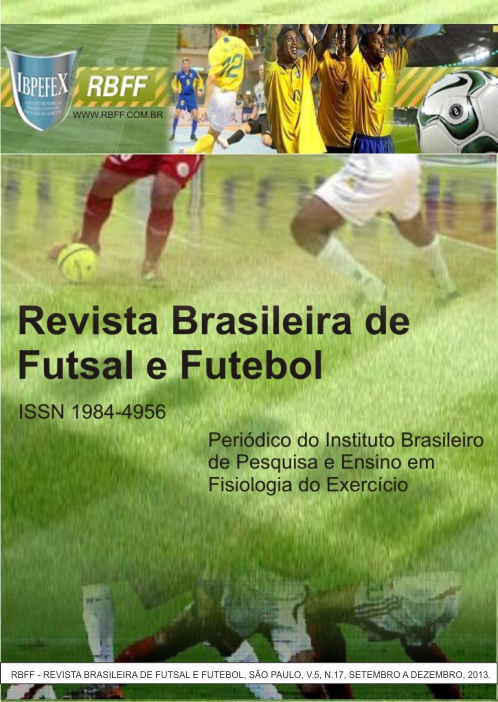Body composition, physical qualities and characteristics athletes selection dermatoglyphicals Brazilian futsal female in position of game
Abstract
The objective of the study was to assess the body composition, physical qualities and dermatoglyphic characteristics of brazilian female futsal athletes selection for game position. Fifteen futsal athletes from adult category, divided into 4 tactics positions (4 goalkeepers, 3 fixed defenders, 5 midfielders, 3 forwards) were evaluated to body mass, stature, % fat, aerobic power (VO2máx.), lower-limbs power and genetic predisposition (dermatoglyfic). The results showed that goalkeepers are taller if compared to midfielder and presented higher body mass when compared to fixed defenders. % fat, aerobic and lower-limbs power as well as genetic predisposition to resistance, speed resistance and coordination were similar among positions. The futsal athletes of the present study showed similar body composition, physical qualities and genetic predisposition characteristics in relation to futsal performance.
References
-Abramova, T.F.; Nikitina, T.M. Impressões Dermatoglíficas: Marcas genéticas na seleção nos tipos de esporte. Atualidades na preparação de atletas nos esportes cíclicos: Coletânea de artigos científicos. Volvograd. p. 86-91.1995.
-Araújo, T.L.; Andrade, D.R.; Figueira Júnior, A. J.; Ferreira, M. Demanda fisiológica durante o jogo de futebol de salão, através da distância percorrida. Revista da Associação dos Professores de Educação Física de Londrina. Vol. 11. Núm. 19. p. 12-20. 1996.
-Avelar, A.; Santos, K.M.; Cyrino, E.S.; e colaboradores. Perfil antropométrico e de desempenho motor de atletas paranaenses de futsal de elite. Revista Brasileira de Cineantropometria e Desempenho Humano. Vol. 10. Núm. 1. p. 76-80. 2008.
-Bello Júnior, A. A ciência do esporte aplicada ao futsal. Sprint. 1998.
-Benvenuti, C.; Minganti, C.; Condello, G.; e colaboradores. Agility assessment in female futsal and soccer players. Medicina (Kaunas). Vol. 46. Núm. 6. p. 415-420. 2010.
-Bosco, C.; Luhtanen, P.; Komi, P.V. A simple method for measurement of mechanical power in jumping. European Journal of Applied Physiology. Vol. 50. p. 273-82. 1983.
-Castagna, C.; D’ottavio, S.; Vera, J.G.; Alvarez, J.C. Match demands of professional futsal: a case study. Journal of Science and Medicine in Sport. Vol. 12. Núm. 4. p. 490-494. 2009.
-Cummins, H.; Midlo, C.H. Palmar andplantar dermatoglyphics in primates. Philadelphia. p. 257. 1942.
-Dantas, P.M.S. Dermathoglyphics characteristics of the brazilian high performance athletes of sportive modalities. Journal of the International Federation of Physical Education. Vol. 74. Núm. 1. p. 87-92. 2004.
-Dantas, P.M.S.; Alonso, L.; Fernandes Filho, J. A dermatoglifia no futsal brasileiro de alto rendimento. Fitness & Performance Journal. Vol. 3. Núm. 3. p. 136-142. 2004.
-Faulkner, L.A. Physiology of swimming and diving. In: H. Falls. Exercise Physiology. Baltimore. Academic Press. 1968.
-Fernandes Filho, J. Impressões dermatoglíficas: marcas genéticas na seleção dos tipos de esporte e lutas a exemplo de desportista do Brasil Tese de Doutorado. Moscou. URSS. 1997.
-Fernandes Filho, J.; Carvalho, J.L.T. Potencialidades desportivas de crianças segundo a escola soviética. Revista Brasileira de Cineantropometria e Desempenho Humano. Vol. 1. Núm. 1. p. 96-107.1999.
-FIFA. Futsal and beach soccer enjoying rising interest, FIFA research shows. 2006. Disponível em http://www.fifa.com/en/media/index/0,1369,122047,00.html. 2007. Acesso em: 20/05/2012.
-Gordon, C.C.; Chumlea, W.C.; Roche, A.F. Stature, recumbent length, and weight. In: Lohman TG, Roche AF, Martorell R, editors. Anthropometric standardization reference manual. Champaign. Human Kinetics Books. p. 3-8. 1988.
-Goulart, L.F.; Dias, R.M.R.; Altimari, L.R. Força isocinética de jogadores de futebol categoria sub-20: comparação entre diferentes posições de jogo. Revista Brasileira de Cineantropometria e Desempenho Humano. Vol. 9. Núm. 2. p. 165-169. 2007.
-Harrison, G.G.; Buskirk, E.R.; Carter, L.J.E.; e colaboradores. Skinfold thickness and measurement technique. In: Lohman, T.G.; Roche, A.F.; Martorell, R.editores. Anthropometric standardization reference manual. Champaign. Illinois.Human Kinetics Books. p. 55-70. 1988.
-Leger, L.A.; Lambert, J. A maximal multistage 20-m shuttle run test to predict VO2max. European Journal of Applied Physiology. Vol. 49. p. 1-12. 1982.
-Maria, T.S.; Almeida, A.G.; Arruda, M. Futsal: treinamento de alto rendimento. Phorte. 2009.
-Queiroga, M.R.; Ferreira, S.A.; Romanzini, M. Perfil antropométricode atletas de futsal feminino de alto nível competitivo conforme a função tática desempenhada no jogo. Revista Brasileira de Cineantropometria e Desempenho Humano. Vol. 7. Núm. 1. p. 30-34. 2005.
-Silva, M.R. O goleiro de futsal: Sua evolução junto com as regras. 2004. TCC de graduação. Londrina. Universidade Estadual de Londrina. 2004.
-Silva Dantas, P.M. Identificação dos perfis genéticos, de aptidão física e somatotípico que caracterizam atletas masculinos de alto rendimento, participantes do futsal adulto, no Brasil. Dissertação Mestrado. Programa de Pós-Graduação em Motricidade Humana. Rio de Janeiro. Universidade Castelo Branco. 2001.
-Wisloff, U.; Helgerud, J.; Hoff, J. Strength and endurance of elite soccer players. Medicine Science and Sports Exercise. Vol. 30. Núm. 3. p. 462-467. 1998.
Authors who publish in this journal agree to the following terms:
- Authors retain the copyright and grant the journal the right of first publication, with work simultaneously licensed under the Creative Commons Attribution License BY-NC which allows the sharing of the work with acknowledgment of the authorship of the work and initial publication in this journal.
- Authors are authorized to enter into additional contracts separately for non-exclusive distribution of the version of the work published in this journal (eg, publishing in institutional repository or book chapter), with acknowledgment of authorship and initial publication in this journal.
- Authors are allowed and encouraged to post and distribute their work online (eg, in institutional repositories or on their personal page) at any point before or during the editorial process, as this can bring about productive change as well as increase impact and impact. citation of published work (See The Effect of Free Access).





